#Pathfinder RPG
Text
6K notes
·
View notes
Text

An extremely elaborate project that I was so honoured to get to take on. The lovely Amalthea, for @hyracia, in this Art Nouveau inspired commission—combining many thematic, floral and decorative elements. I am so thrilled with the result✨ Thank you!!!
342 notes
·
View notes
Text

Ot'lar, Iruxi barbarian and the Maw of the jungle (Belgian flag was unintended). Commission for Mjod
272 notes
·
View notes
Text

Besmara - The Pirate Queen
Back on my bullshit with my Gods of Golarion project.
71 notes
·
View notes
Text
Pathfinder 1e take. Humanoid infants should count as animals in addition to their other types until they reach a certain age threshold.
1 year for humans, half-elves, and halflings
2 for dwarves and gnomes
7 for elves
Half-orcs are treated as full-humanoids at birth
@dailycharacteroption @bogleech @monstersdownthepath @thecreaturecodex
55 notes
·
View notes
Text
PF1: GRAVE HAG
Hello! Here's another of my attempts at retro-converting a 2E critter to 1E stats. After the Rust Hag, I surely couldn't pass up the Grave Hag, especially since I think Hags are kinda underrated and can be just as terrifying and versatile as vampires and liches when it comes to being evil masterminds.
Again I've tried to be as close as possible to the original version, though I had to drop a few special abilities in the process, since I was afraid they would have made the conversion overpowered. I'm still wondering if my conversion here might be a bit much... but I'll let you guys be the judges of that.
Hope you enjoy it!
GRAVE HAG

Image © Paizo Publishing. Accessed at Archives of Nethys here
This woman has a cadaverous appearence, with greying flesh, filthy black hair and bloody sores all over her body. Her nails are long, ragged claws, and her clothes are soiled with grave dirt.
GRAVE HAG CR 9
XP 6’400
CE Medium Monstrous Humanoid
Init +3; Senses darkvision 60 ft.; Perception +18
DEFENSE
AC 23 (+3 Dex, +1 dodge, +9 natural), touch 14, flat-footed 19
hp 104 (11d10+44)
Fort +8, Ref +10, Will +11; +4 vs. disease, fear and paralysis
Defensive Abilities negative healing
Damage Reduction 5 / cold iron; Immune energy drain, poison; Spell Resistance 20
ATTACK
Speed 30 ft.
Melee improvised weapon +17 / +12 / +7 (1d8+7) or 2 claws +17 (1d6+5 plus grab)
Ranged grave ray +15 touch (4d6)
Special Attacks curse of the grave, grave ray
Spell-Like Abilities (CL 12th, concentration +15)
1/day – cloudkill (DC 18)
3/day – animate dead, contagion (DC 18), enervation (DC 18), vampiric touch
At will – bleed (DC 14), cause fear (DC 15), command undead (DC 16), death knell (DC 15), speak with dead (DC 17)
STATISTICS
Str 20, Dex 17, Con 16, Int 19, Wis 18, Cha 17
Base Atk +12; CMB +17 (+21 grapple); CMD 30
Feats Catch Off-Guard (B), Dodge, Great Fortitude, Power Attack, Spell Focus (necromancy), Toughness, Undead Master
Skills Bluff +14, Climb +10, Craft (any one) +10, Heal +11, Intimidate +15, Knowledge (arcana) +14, Knowledge (religion) +16, Perception +18, Sense Motive +12, Spellcraft +12, Stealth +14, Survival +10
Languages Aklo, Common, Giant, Necril
Special Qualities undead mien
ECOLOGY
Environment any
Organization solitary or coven (3 hags of any type)
Treasure standard
SPECIAL ABILITIES
Curse of the Grave (Sup): Three times per day, a grave hag can put a curse on a creature, rendering it more enticing to the ravenous undead. A target can avoid this effect by making a successful Will save (DC 18). If the save is failed, the target starts drawing the undead’s attention, granting them a +4 bonus on Perception checks to notice the affected creature and on saving throws to resist spells that hide or disguise the affected creature from undead (such as hide from undead). Once an undead notices the affected creature, it feels compelled to kill and devour the affected creature, and gains a +2 profane bonus on attack rolls made against the affected creature and a +2 profane bonus on saving throws against the affected creature’s spells and special abilities. The undead also ignores any concealment less than total concealment that an affected creature has. A curse of the grave lasts for 24 hours or until removed with a successful remove curse, dispel magic, break enchantment or similar magic (against a casting level of 12). The save DC is Charisma-based.
Grave Ray (Sup): Once every 1d4+1 rounds, a grave hag can fire a black beam of bone-chilling negative energy to a maximum range of 60 feet. If the grave hag succeeds at a ranged touch attack, the beam inflicts 4d6 point of negative energy damage, which can be halved on a successful Fortitude save (DC 18). A grave ray can be used to heal undead creatures, or the grave hag herself, in this way. The save DC is Charisma-based.
Negative Healing (Sup): A grave hag is healed by negative energy and harmed by positive energy as if she were an undead creature.
Undead Mien (Ex): A grave hag counts as an undead creature for the purpose of spells, spell-like abilities or special abilities that detect undead. She also gains a +4 racial bonus on saving throws vs. disease, fear and paralysis effects.
Grave hags are a particularly powerful breed of hags with an affinity for undead and negative energy, who make their liars in cemetaries, mausoleums or other burial sites, where they surround themselves with undead servitors and form a kind of twisted mockery of a court. Unlike most hags, grave hags do not have the ability to alter their appearence into a more reassuring shape, and are forced to hide where few people would want to seek them out. However, grave hags are grieviously arrogant and self-centered, and believe that this kind of life is beneath them, so they spend most of their time concocting plans to expand their territory and set themselves up as petty rulers of undead-infested regions.
Even for the standards of hags, grave hags are extremely smug and self-important, seeing themselves as the most powerful, cunning and strongest of all hags, and demanding respect and unconditional obedience from any “lesser” kind of hag. They tend to mock other hags’ abilities that they don’t possess (such as the ability to alter self) as pointless parlor tricks who have no inherent use to them. The exception to this are night hags, whom are seen by grave hags as role models, and to whom a grave hag will gladly submit.
In combat, grave hags tend to hold back and harass opponents with spells and withering blasts of negative energy while their undead minions tear their victims apart. They often open up combat by casting cloudkill and then letting their minions, unaffected by the poison, have their way with the opposition. Grave hags can put a curse on their victims, making them more enticing for the undead to attack. However, if forced to hand-to-hand combat, a grave hag can give as good as she gets, often using digging tools like shovels or mattocks as improvised weapons with surprising skill.
A grave hag usually stands between 5 and 6 feet tall and weighs between 120 and 180 pounds. The bloody sores she naturally sports on her body can make her look crippled and weak, but are merely cosmetical and do not hinder the grave hag in any way other than giving her an unsightly appearence. When a grave hag joins a coven, the coven adds harm to its spell-like abilities and shares the grave hag’s negative healing ability, but a grave hag will rarely join a coven that doesn’t have either herself or a night hag as leader.
33 notes
·
View notes
Text

More of these friends because I have the brainrot
#fantasy art#dnd#pathfinder#pathfinder rpg#Pent#Tevildo#Ikavod#Rain#Rain going full goblin mode in session 1 was hilarious#campaign: The Fickle Family
47 notes
·
View notes
Text


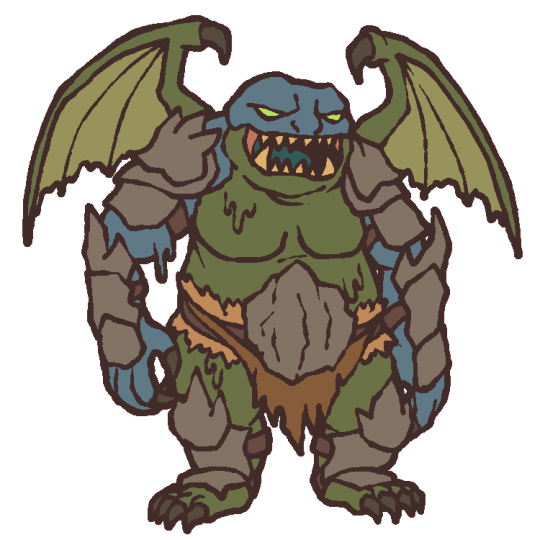
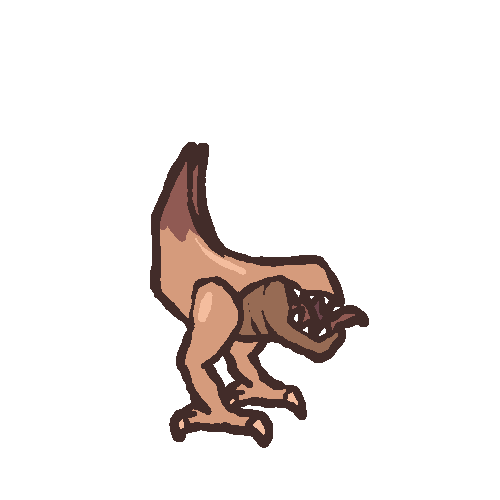



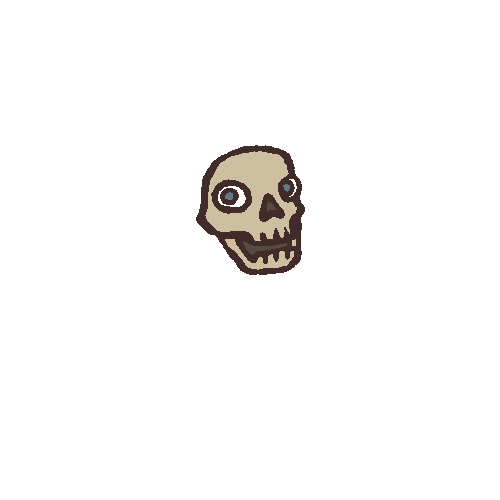
This time we've got some demons, a demodand, constructs, and everyone's favorite floating skull Morte.
Some of these, like the armanite or fluxcharger, have been on my to-draw list forever now, so it feels good to finally knock em out.
#d&d#pathfinder rpg#d&d 5e#d&d characters#character portraits#d&d minis#paper minis#demon#demodand#armanite#kelubar#kolyarut#inevitable#morte#abyssal chicken#fluxcharger
21 notes
·
View notes
Photo
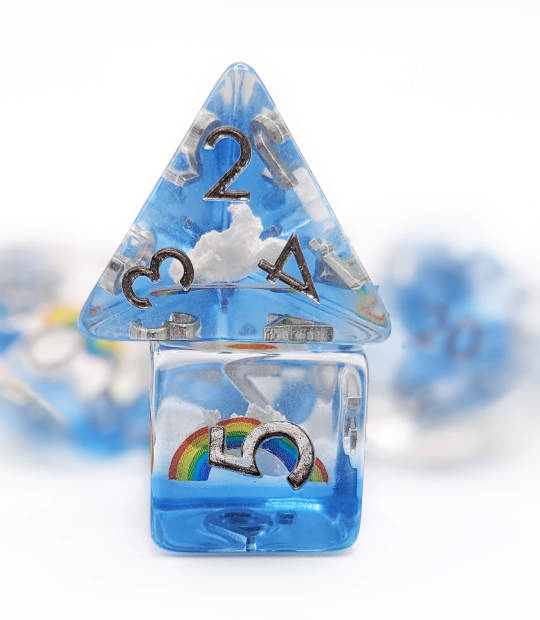
Today's gaming forecast calls for blue skies and rainbows.
#rainbow#dice#rainbow dice#beautiful dice#blue dice#dark elf dice#rpg dice#dnd dice#ttrpg dice#ttrpg#dnd#dungeons and dragons#pathfinder rpg#ttrpg stuff#dnd stuff#d6#d4#d20#dice life#dice goblin#dice hoarder#dice collection#game#tabletop roleplaying games
159 notes
·
View notes
Text

Another Halfling from @mlarayoukai . Laranna Eversky, Fighter/Paladin of Kord (Kurgess if I play her in Pathfinder, Dol Dorn if in Eberron). Transfemme but still swole and candy-colored AF (you can't fight the forces of evil if you ain't cute). Loves her riding mule, Benny, loves tests of strength, and will make any bad decision necessary in pursuit of trying a new booze. Doesn't show up so well in this art style (which I still love!) but she's jacked to the point she's been mistaken for a shorter Dwarf on more than one occasion.
#laranna eversky#halflings#my ocs#my commissions#dungeons & dragons#dungeons and dragons#d&d#dnd#pathfinder#pathfinder rpg#eberron#kord#kurgess#dol dorn
25 notes
·
View notes
Text
Monster Art History: The Wendigo
You may be wondering why the wendigo, which has become very popular in pop culture over the last 10 years or so, is usually depicted in Western sources with a deer head. This appears nowhere in Native American traditions, despite the creature having lots of folkloric variations. The association of the wendigo with deer is 100% Western, 100% modern, and has a long, weird history.
Just in case you need a primer, the windigo or witiko is a supernatural being from the Algonquin speaking nations of the eastern American continent. It appears as an emaciated figure, sometimes giant, sometimes covered in ice, sometimes both. In many stories, they have a literal heart of ice. Windigos are manifestations of cannibalism and winter, and hunt, kill and eat people. Someone who resorts to cannibalism to survive, or otherwise abandons their community for personal gain, will become one of them. A few stories tell of someone being “cured” and turned back into a human, but usually the only cure is to kill the monster. In the last several decades, native writers have associated windigos with capitalism and deforestation as an extension of their selfishness. If you would like to know more about the properly Native windigo in context, I recommend Dangerous Spirits: The Windigo in Myth and History by Shawn Smallman.
The creature first came into horror fiction with Algernon Blackwood’s “The Wendigo”. Note the spelling, which would become the standard in horror, and generally in non-academic Western sources. In that story, it is not associated with cannibalism, but instead is a more generic “evil spirit of nature”. This wendigo stalks white people in the wilderness and turns a Native character into a new wendigo by seizing them and flying with them into the sky. This definitely better fits fears about non white people, fears about nature, and how the one is closer to the other than “civilized” people. Its description in the story is vague (the most we get is that it has burned its feet away by running into the sky). But when the story appeared in Weird Tales in the 1930s, Virgil Finlay illustrated it like this, the first antlered wendigo I know of.

This story was ripped off by August Derleth, a prominent Weird author in the 1940s and the main popularizer of HP Lovecraft. In his Cthulhu Mythos stories, he introduces Ithaqua the Wind Walker, which is an alien version of Blackwood’s monster. This fits into Derleth’s vision of the gods and monsters of HP Lovecraft falling into the four classical elements, with Ithaqua being invented to represent Air. Ithaqua is usually depicted as an icy, emaciated giant, so ironically is one of the more accurate wendigos to Indigeonous beliefs in pop culture.
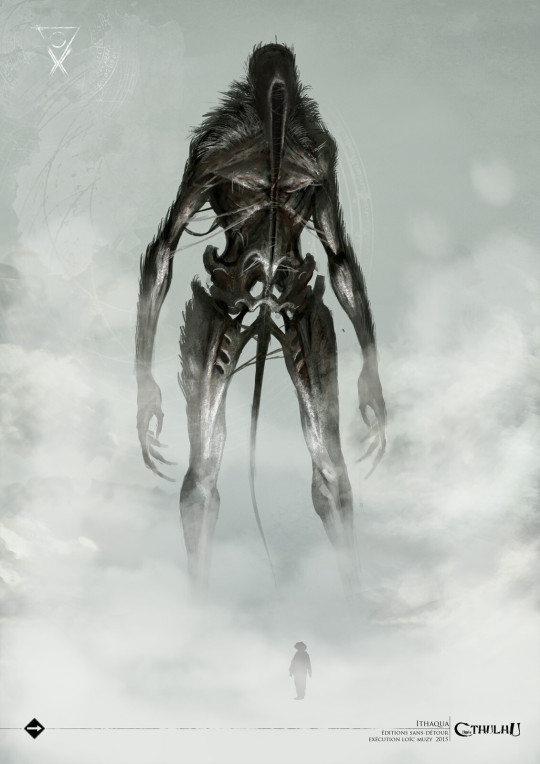
Image from a recent French edition of Call of Cthulhu RPG, by Loic Muzy
In Pet Sematary, Stephen King uses a wendigo as the reason for why the titular cemetery is cursed. This is an update of the classic racist trope of the “Indian Burial Ground”, except this time what gets buried there comes back animalistic and evil. The racist implications of that are pretty apparent. This wendigo is seen briefly and has ram’s horns. It does not appear in the first film adaptation, but does in the more recent one... with deer horns instead, because those are trendy right now.
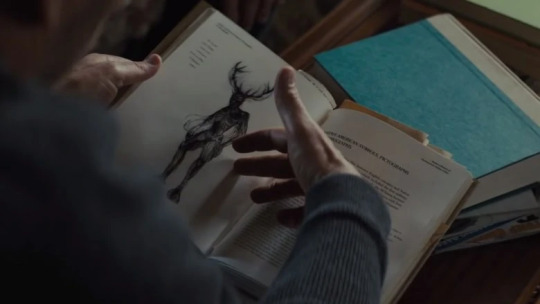
A good scholarly look at the real windigo versus the 20th century horror wendigo is “The Appropriation of the Windigo Spirit in Horror Literature” by Kallie Hunchman.
In the 1980s, a movie called Frostbiter: Wrath of the Wendigo was produced, but it wasn’t released until 1995 by Troma. From what I’ve read, it’s a pretty transparent ripoff of Evil Dead 2, with the characters being picked off in a haunted cabin with a zombie in the basement. The “twist” is that the origin of the horrors is a wendigo released by breaking a Christian demonology-style sacred circle. This wendigo is realized in stop motion animation, and has the most deer-like body yet.

A number of other independent horror movies in the 90s and 2000s used wendigos as a plot element. These follow the Blackwood/King approach of having the wendigo being something evil, ancient and Native American, reflecting white anxieties about living on stolen land more than Native anxieties about cannibalism and greed. Wendigo (2001) has the creature sicced on a white family when they hit a deer with their car. The Last Winter (2006) posits that global warming and fossil fuel extraction have unleashed the ghosts of dead animals, which are wendigo apparently, to revenge themselves on mankind. Which approaches the idea that greed is wendigo sickness, but I don’t think intentionally as a reference to modern Native literature. The “wendigo” in this movie are spectral moose and caribou.

The mainstream breakthrough of the deer-headed wendigo was in, appropriately enough for this blog, Pathfinder RPG. In “Spires of Xin-Shalast”, the last volume of Rise of the Runelords published in 2008, a wendigo is a major encounter. I suspect that either the author (Greg A. Vaughn), or one of the editorial staff had seen Frostbiter, as the setup involves a cabin haunted by dwarven cannibal ghosts who all killed and ate each other due to a wendigo’s influence. This wendigo is a hybrid of the Blackwood and Cree versions in terms of its MO: it is a cannibal ice spirit that wants to make more cannibals, and does so by abducting people and running off into the sky with them. Its design is the standard for what most Western artists depict wendigos as these days: an emaciated humanoid with the head and antlers of a deer (and the burned off feet of Algernon Blackwood, which are less common):
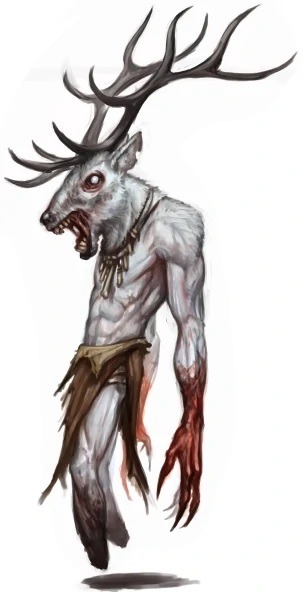
Image by Tyler Walpole, © Paizo Publishing
This wendigo definitely made a splash at the time; it was the first time I remember seeing a deer-headed wendigo, and art of that design started to become common. It pushed away previous wendigo depictions, which were typically werewolves (as French Canadian trappers had blended the concept with their own loup-garou, and Werewolf the Apocalypse had a whole faction of racist Native American “wendigos”) or shaggy and ape like (based more on the look of the Marvel Comics villain).
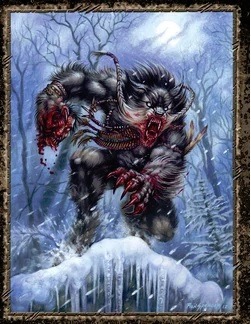
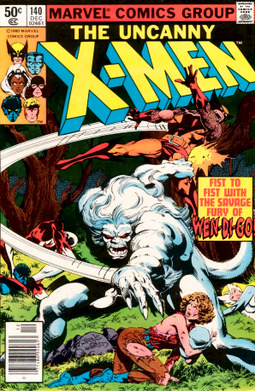
What turned wendigos from “folklore/horror monster” to “fandom blorbo” was Hannibal, which first aired in 2013. In that series, the first murder is a woman’s body impaled on a stag’s head, after which protagonist Will Graham has visions of a black stag, and a man with the antlers of a stag, representing murder, evil, and of course the cannibalistic murderer Hannibal Lecter.

Since Hannibal was super popular with the shipping fandom set, wendigo themed characters became popular in its wake, creating a wholly new way to culturally appropriate the wendigo. This was magnified by Over the Garden Wall, which came out in 2014, and its villain The Beast. The Beast is never called a wendigo, but is an antlered giant associated with winter, and so is commonly head-canoned as a wendigo and associated with them in fandom circles.

Which gets us to the modern day, where teenagers have misunderstood wendigo OCs, any character with antlers can be called a wendigo on the internet, and actual First Nations people with an actual cultural connection to the legend wish that people would just knock it off.
#and now you know#wendigo#windigo#witiko#creature design#art history#pathfinder rpg#algernon blackwood#august derleth#cthulhu mythos#stephen king#b movies#stop motion#hannibal#native american#first nations#cultural appropriation#long post
2K notes
·
View notes
Text
The party is approached by a group of ragged kids who want to enlist their help in protecting their lemonade stand.
They set one up but are being harrassed by some NIMBY Karens who think that it is bringing down their property values.
100 notes
·
View notes
Text
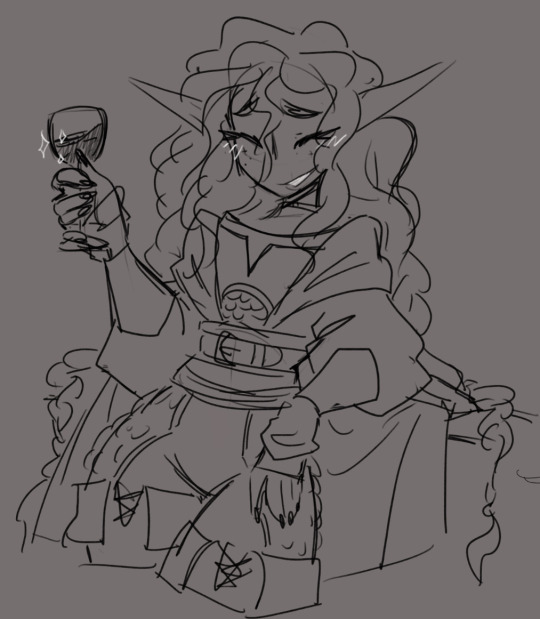
cheers to the dragonslayers...
we defeated the molten king at the end of book 4 of age of ashes! on to some hard-earned downtime!
#pixdoodles#pathfinder#age of ashes#pathfinder rpg#pathfinder 1e#calliope is SO done with hot places#if i ever see a pool of lava again it will be FAR too soon
30 notes
·
View notes
Text
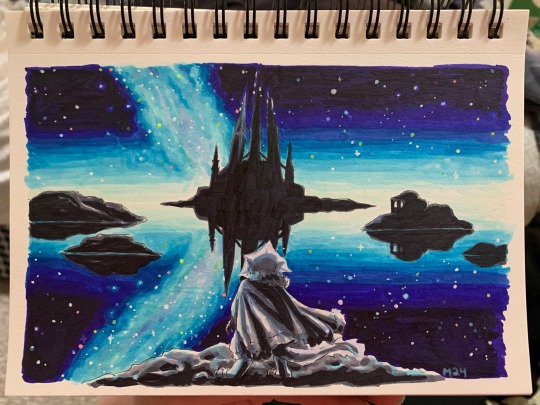
As requested, Ser’Koh the Bold is here.
This is after he drank some special tea to go and talk to god lmao
15 notes
·
View notes
Text
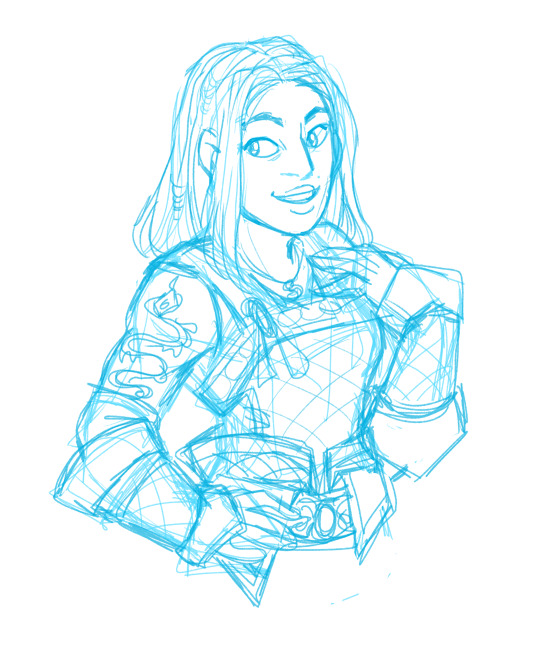
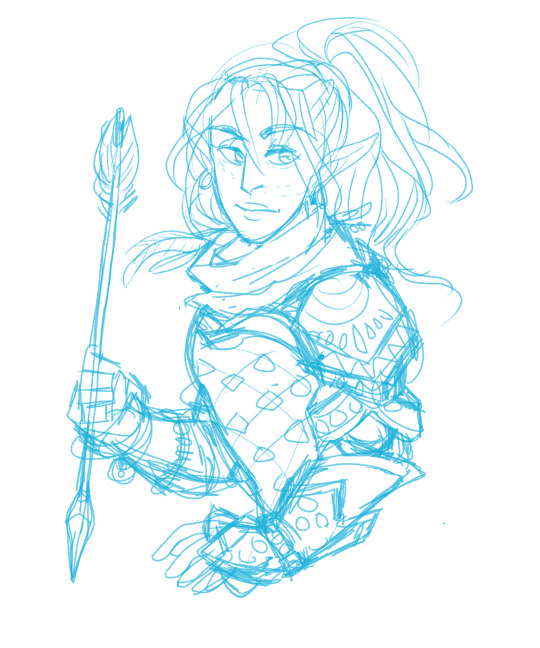
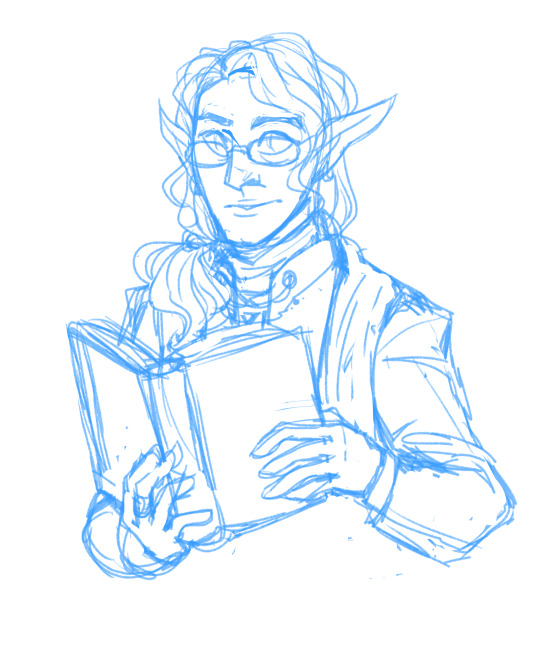
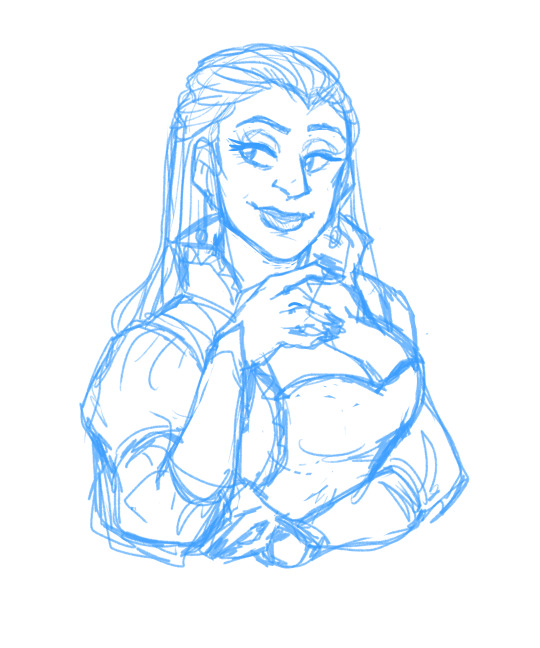
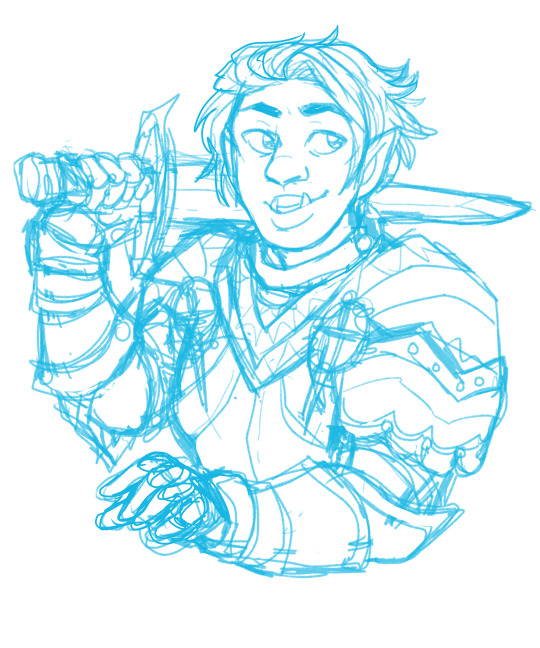

been doodling some portraits of various Pathfinder NPCS!
26 notes
·
View notes
Photo

Handful of paper miniature designs I’ve done over the years.
Can checkout more of my work and/or download the paper miniature files here: www.printableheroes.com
78 notes
·
View notes